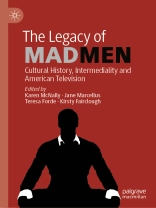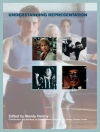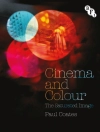For seven seasons, viewers worldwide watched as ad man Don Draper moved from adultery to self-discovery, secretary Peggy Olson became a take-no-prisoners businesswoman, object-of-the-gaze Joan Holloway developed a feminist consciousness, executive Roger Sterling tripped on LSD, and smarmy Pete Campbell became a surprisingly nice guy. Mad Men defined a pivotal moment for television, earning an enduring place in the medium’s history.
This edited collection examines the enduringly popular television series as Mad Men still captivates audiences and scholars in its nuanced depiction of a complex decade. This is the first book to offer an analysis of Mad Men in its entirety, exploring the cyclical and episodic structure of the long form series and investigating issues of representation, power and social change. The collection establishes the show’s legacy in televisual terms, and brings it up to date through an examination of itscultural importance in the Trump era. Aimed at scholars and interested general readers, the book illustrates the ways in which Mad Men has become a cultural marker for reflecting upon contemporary television and politics.
Jadual kandungan
Chapter 1 Jane Marcellus, Introduction: Where the Truth Still Lies.- Mad Men ’s Status: Television, Reputation, Fandom.- Chapter 2 Gary R. Edgerton, Mad Men’s Legacy in the Quality Television Tradition.- Chapter 3 Andrée E. C. Betancourt, Mad Men, Maddicts, and Recapturing the Carousel: From Kodak Moments to Selfies .- Chapter 4 Trisha Dunleavy, Mad Men and Complex Seriality.- Gender and Race: The Complex Management of Power.- Chapter 5 Rod Carveth, The Depiction of the Civil Rights Movement on Mad Men.- Chapter 6 Mimi White, Mad Men, Women, and the Lure of Feminism.- Chapter 7 Maryn C. Wilkinson, The Performativity of Labour and Femininity on Mad Men.- Chapter 8 Tracy Lucht and Jane Marcellus, Mad Men, Corporate Culture, and Violence Against Women.- Mad Men ’s Intermediality: Film, Music, Poetics.- Chapter 9 Emily Hoffman, Don Draper and the Enduring Appeal of Antonioni’s La Notte.- Chapter 10 Zak Roman, Mad Men’s Midcentury Modern Times.- Chapter 11 Rachel Donegan, Delicious Ambiguities: Mad Men’s Use of The Beatles, Nancy Sinatra, and Judy Collins in Seasons Five and Six.- Chapter 12 Honora Kenney, Using Bakhtin’s ‘Third Ear’ to Hear Mad Men’s Adspeak in the Everyday.- Chapter 13 Aaron Herschel Shapiro, Mad Men and the Staging of Literature: Ken Cosgrove and His Problems.- Endings and Legacies: The Final Season.- Chapter 14 Marjolaine Boutet, Mad Men’s Finale and the Making of History.- Chapter 15 Kristina Graour, The Dismantling of Narrative ‘Machinery’ in Mad Men’s Finale: Ending an Era.- Chapter 16 Marisa Carroll, What Jungian Psychology Can Tell Us About Don Draper’s Unexpected Embrace of Leonard in Mad Men’s Finale.- Chapter 17 Karen Mc Nally and Teresa Forde, Afterword: Reading Mad Men in the Era of Trump
Mengenai Pengarang
Karen Mc Nally is Senior Lecturer in Film and Television Studies at London Metropolitan University, UK and has published on stardom, gender and race in Hollywood Cinema.
Jane Marcellus is Professor of Media History and Cultural Studies at Middle Tennessee State University, USA and has published on feminism and media history, with a focus on the representation of employed women.
Teresa Forde is Senior Lecturer in Film and Media at the University of Derby, UK and has published on gender, science fiction, soundtracks and memory.
Kirsty Fairclough is Associate Dean: Research and Innovation at the University of Salford, UK and has published on race, gender, popular music and celebrity.












